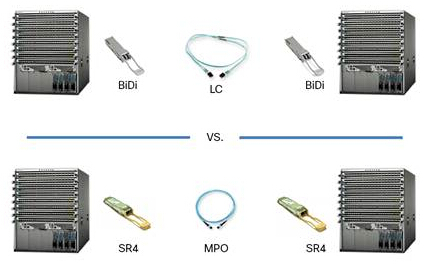With the data center consolidation, server virtualization, and new applications requiring higher data transport rates, the data center network is shifting to 10 Gbps at the access layer and 40 Gbps at the aggregation layer. In order to support 40-Gbps connectivity, data center architects are challenged by the need for a major upgrade of the cabling infrastructure, which can be too expensive or disruptive to allow data centers to quickly adopt and migrate to the 40-Gbps technology.
Standard 40G short-reach transceivers use fundamentally different connectivity formats, requiring fiber cabling infrastructure to be redesigned and replaced. 40G SR protocols, such as SR4 and CSR4, operate over MMF ribbon with MPO connectors. Consequently, the 40G MPO-based SR4 transceivers cannot reuse aggregation fiber infrastructure built for 10G connectivity.
Connector type is not the only concern. 40GBASE-SR4 and 40GBASE-CSR4 transceivers require a theoretical minimum of 8 fiber strands, and often 12 fiber strands in practice. This is because that 40GBASE-SR4 and 40GBASE-CSR4 use 4 parallel fiber pairs (8 fiber strands) at 10 Gbps each for a total of 40 Gbps full duplex. However, both use MPO-12 connectors, which terminate 12-fiber ribbons. As a result, 4 fiber strands in each connection are unused and wasted.
In order to economize trunk fiber in a structured cabling environment, a 2 x 3 MPO fiber conversion module could combine three SR4 links onto two 12-fiber ribbon cables. But even then the 40G SR4 trunk still uses 8 fiber strands per link compared to 2 fiber strands in the case of SFP 10G SR.
The 40G QSFP BiDi transceiver transmits full duplex 40G traffic over one dual-fiber LC connector OM3 or OM4 MMF cable. It provides the capability to reuse 10G fiber infrastructure. In other words, the 40G QSFP BiDi transceiver enables data center operators to upgrade to 40G connectivity without making any changes to the previous 10G fiber cable plant.
The QSFP BiDi transceiver has two 20G channels, each transmitted and received simultaneously over two wavelengths on a single MMF strand. The result is an aggregated duplex 40G link over a MMF duplex LC-terminated fiber cable. The 40GBASE-SR BiDi QSFP transceiver can reach 100 meters on OM3 MMF or 150 meters on OM4 MMF, which is the same as 40GBASE-SR4 transceiver. The picture below shows the working concept of 40G QSFP BiDi transceiver.

In an unstructured cabling system, devices are connected directly with fiber cables. This direct-attachment design can be used to connect devices within short distances in a data center network. As shown in the following picture, direct connection between two 40G devices can be provided by MMF cables with either QSFP SR4 or QSFP BiDi transceivers at two ends.

The QSFP SR4 transceiver uses MPO-12 connectors, whereas QSFP BiDi uses LC connectors. Existing 10G connections commonly are MMF cables with LC connectors. Therefore, with QSFP SR4 transceivers, none of the existing 10G MMF cables can be reused because the connector types are different. QSFP BiDi transceiver allows cable reuse, resulting in zero-cost cabling migration from direct 10G connections to direct 40G connections.
QSFP BiDi technology removes 40G cabling cost barriers for migration from 10G to 40G connectivity in data center networks. The 40G QSFP BiDi transceivers provide 40G connectivity with immense savings and simplicity compared to other 40G QSFP transceivers. It provides a cost-effective solution for migration from 10G to 40G infrastructure.